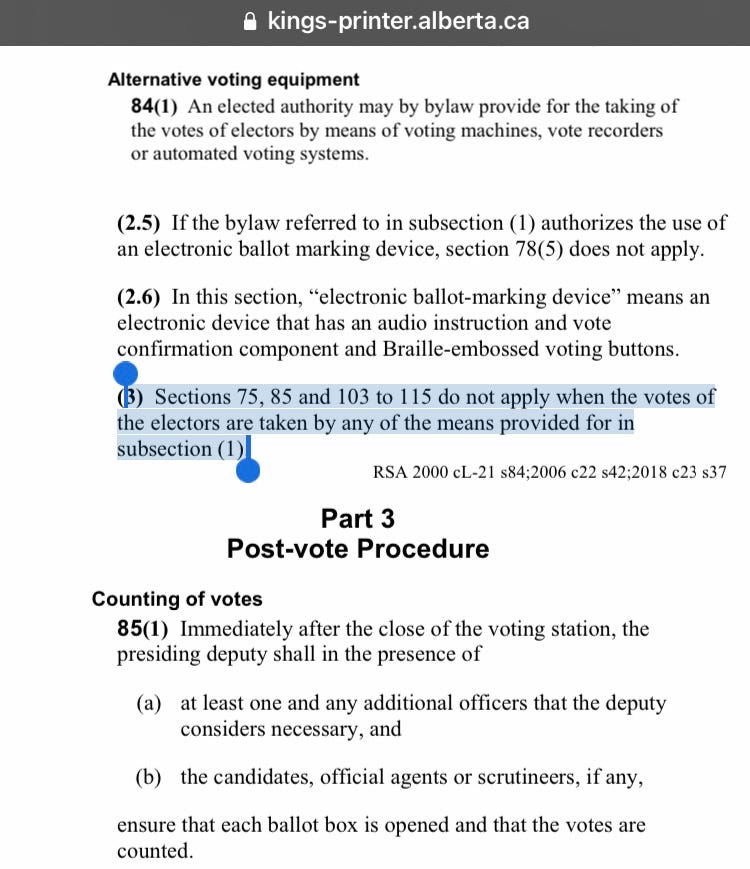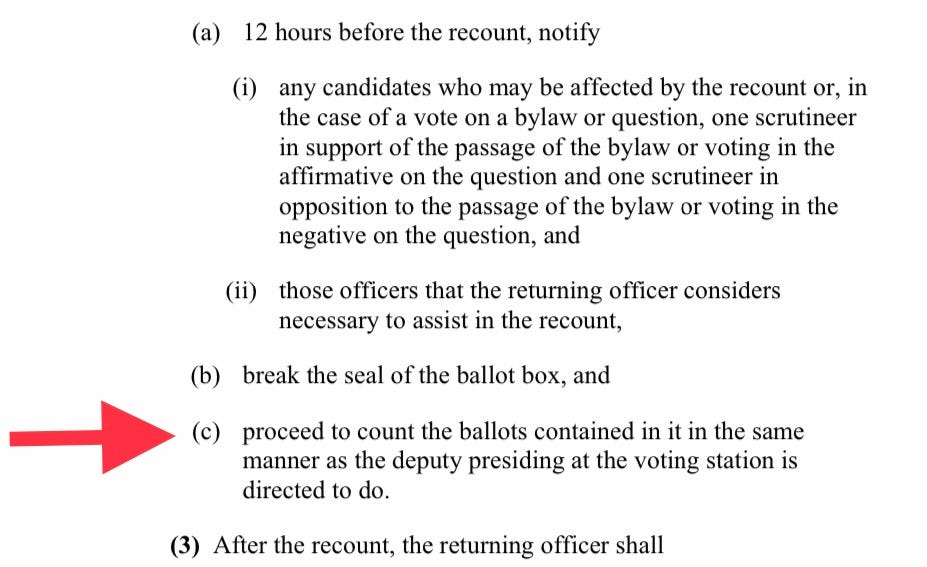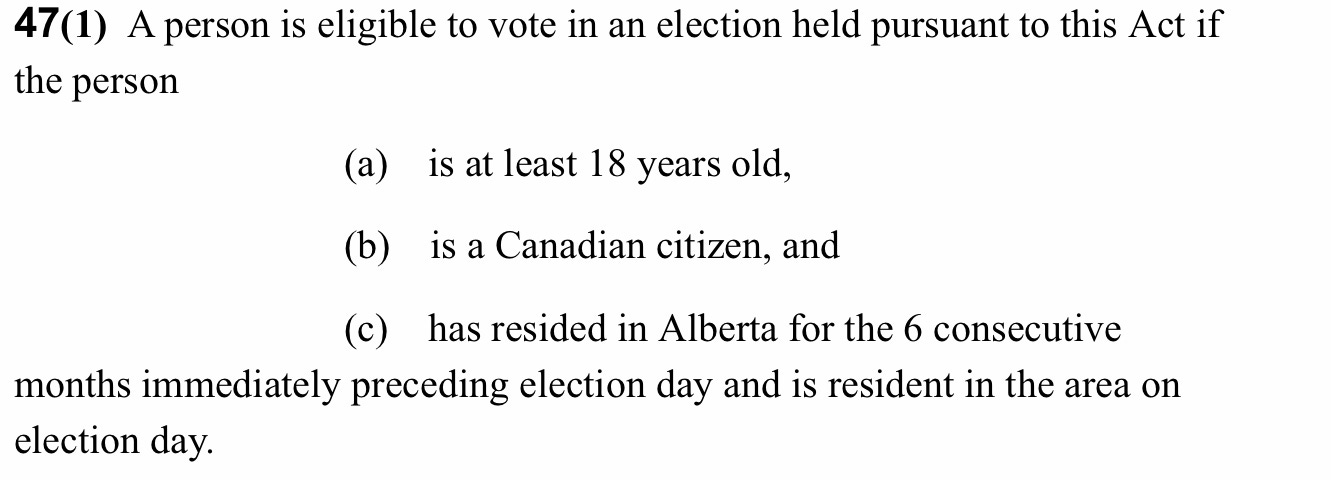The Local Authorities Elections Act
The Local Authorities Elections Act (LAEA) is an act put forth by the provincial Government of Alberta and managed by Municipal Affairs. After an election the Ministry reaches out in different ways and to different stakeholders to gather feedback and suggestions on how to improve the LAEA. With help from the Returning Officers, Election Staff, Candidates and Alberta Municipalities, formerly known as the Alberta Urban Municipalities Assosiation (AUMA), suggestions are submitted to the Policy Unit, a unit in the Municipal Services Division of Alberta Municipal Affairs. The Policy Unit gathers this information and summarizes it for the Ministers review. Ultimately, any changes to the LAEA are made through the Legislative Body. It’s the LAEA that frames the legislation used to manage all municipal elections in Alberta.
Electronic Tabulation Machines
A copy of the LAEA that was first published in 2002 can be found from the records of the Canadian Legal Information Institute (CanII), it was to replace The Local Authorities Board Act that was published in 1980. When the LAEA was first introduced into law it included clause 84, the clause that introduced legislation for tabulators and electronic voting machines.

Electronic tabulation machines were first introduced to Calgary back in 2018 by Returning Officer Laura Kennedy. In June of 2018 a suggestion was put forth by Kennedy into Calgary’s City Council to use vote tabulation machines for the upcoming Olympic plebiscite, this on the heels of the 2017 municipal election, what was considered Calgary’s most overwhelmed and under prepared election in the cities election history.
Naheed Nenshi, who won his third term as mayor for the City of Calgary said he’s not keen on paperless ballots, but would consider electronic tabulation to more quickly determine results.
From Calgary city council (transcription):
Mayor Nenshi:Are the paper ballots ever counted?
Chief Returning Officer Laura Kennedy:The paper ballots are counted as they go through the tabulator. If theres a recount required, then we would use the paper ballots which would run through a recalibrated machine to verify it that way.
So, there’s never a…
Nenshi:There’s never a hand count.
Kennedy:Never a hand count.
Recounts involving Tabulation Machines
Elections in Alberta have a series of sections in the LAEA that outline the process of how a recount can be conducted in the event of a challenge from a candidate or evidence of malicious intent. Once electronic machines such as tabulators are used instead of a hand count, this process takes on a different order of sections in the LAEA. The format of the recount is encompassed in sections 84, 98, 105-115, below is a breakdown of the sections of the LAEA to help better understand the recount process.
Section 84(1) from the Local Authorities Elections Act, is the first step for a recount that involves electronic tabulation machines.
Next section 84(3) is for re-counts where electronic tabulation machines are used making sections 75, 85 and 103 to 115 irrelevant.

Section 85 of the post-vote procedure for counting the votes does not apply where tabulators are used.
The step for a recount involving electronic tabulation machines is section 98, subsection ( c ) states the ballots are to be counted in the same manner as the voting station in question was directed to do, ie. electronic tabulation machines.

Due to section 84(3) section 103 that outlines a judicial recount does not apply where tabulators are used, this was the section that cited by the judge as to why a judicial recount was not possible after the 2021 Calgary municiple election ward 4 challenger DJ Kelly called for a judicial recount after Sean Chu won by 100 votes.

After the 2021 Calgary municipal election, a report with a list of recommendations for the LAEA was submitted from the City of Calgary returning officer Kate Martin. One of the recommendations on page 6 of the summary was the topic of a judicial recount where tabulators were used. One of the recommendations outlined the possibility of a hand recount however the hand count recommendation never made it into the updated amendments of the current LAEA.
Eligible Voters in Alberta
In the LAEA before 2018 section 47(1) stated that for a person to be eligible to vote in any municipal election within Alberta, that person must be a resident for at least 6 consecutive months before the day of the election.
Eligible Voters in Alberta
In the LAEA before 2018 section 47(1) stated that for a person to be eligible to vote in any municipal election within Alberta, that person must be a resident for at least 6 consecutive months before the day of the election.

Before the Olympic plebiscite in 2018 Laura Kennedy submitted to the Intergovernmental Affairs Committee her report of recommended changes to the LAEA for future elections. Among the recommendations was a suggestion to remove the six month residency requirement that would allow any Canadian citizen to be eligible to vote the day they became a resident of Alberta.

After the recommendations from Kennedy, the LAEA was updated with the amended section 47(1) removing the 6 month residency requirement for Albertans to be eligible to vote in municipal elections. During the 2021 municipal elections in Calgary & Edmonton anyone who became a resident of Alberta the day before the elections became an eligible voter.